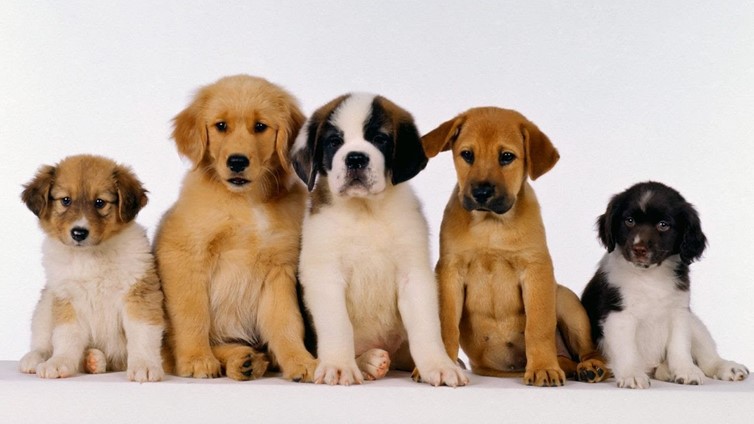Humans have bred dogs for specific behaviors or traits for centuries, developing breeds with special ‘skills’.
For thousands of years, humans have changed their sizes, coats, colors, and even shapes through selective breeding. However, it seems that along the way humans went even one step further. A new study shows that this selectivity has led to reshaped dog brains.
Centuries Of Breeding
Humans have bred dogs from prehistoric times to the present day, for fun, work, and companionship.
For example, the initial role of Siberian huskies and Alaskan malamutes was to pull sleds, Basenji had to scare lions form animals so tribes could hunt, while Beagles were bred to track prey.
There are hundreds of dog breeds around the globe, from massive Pyrenean Mastiff to Papillon Dog – all thanks to long-lasting breeding by humans.
With so diverse range of dog temperament and sizes, it’s no surprise that humans have reshaped their brains as well in the process. A new study performed MRI scans on 33 different breeds and discovered how a dog was bred is reflected in their brain structure.
For example, dogs bred to be small – say the Pug – have flat nose and almost round head with similarly round brains that take up most of their skull.
On the other hand, larger breed such as Borador has a long and narrow head, and in this manner a more elongated brain that simply doesn’t fill all of the skull space.
Humans Have Reordered Dog Brains
A new brain study examined how selective breeding by humans actually ‘has altered the gross organization of the brain in dogs’ and it in order to examine that the study involved 62 male and female dogs of 33 breeds.
Strikingly, neuroanatomical variation is plainly visible across dog breeds.
According to Erin E. Hecht, an evolutionary neuroscientist at Harvard University ‘the biggest moment was just looking at the scans’.
According to Erin, it was extraordinary to see scans because no fancy statistics can tell what’s going on in dogs brain.
Anyway, this is a new way or even a fresh look inside the mind of dogs, because it offers a far better understanding of how breeds are hardwired. In turn it helps potential dog owners to choose the right dog for their home.
Examining The Dog’s Brain
Erin and her team recruited all together 62 individual pet dogs from American homes. The accent here was on a diversity of the breeds.
Therefore, these breeds were: Basset Hound, Beagle, bichon frise, Border Collie, Boston Terrier, Boxer, Bulldog, Cavalier King Charles spaniel, Cocker Spaniel, Dachshund, Doberman pinscher, English Pointer, German Short Haired Pointer, Golden Retriever, Greyhound, Jack Russell Terrier, Keeshond, Labrador Retriever, Lhasa Apso, Maltese, Miniature Schnauzer, Old English Sheepdog, Pit Bull, Siberian Husky, Silky Terrier, Springer Spaniel, Standard Poodle, Weimaraner, Welsh Corgi, West Highland White Terrier, Wheaten Terrier, Whippet, and Yorkshire Terrier.
The difference that team noted was seen in brain shape and size. After that, the further analyzed showed also the differences within the brain. They were observing how certain regions varied across breeds with certain behavioral traits.
For example, Bulldogs were originally bred to fight captive bulls, but their role changes with time and they went for being known as ‘sport fighting’ dog group to ‘companionship’ dog group.
After that, the scientist mapped out six brain networks that could determine a dog’s behavior, like companionship or scent hunting.
Dog’s brain in a nutshell: there is a part of the brain called prefrontal cortex, and that area is linked with group size and social interaction.
Furthermore, that area is responsible for variation among dog breeds for war, police, military work; herding; sport fighting; retrieving; vermin control; or bird flushing.
When you take a deeper look it makes sense, since these breeds serve roles that are – according to Hecht ‘cognitively complex and demanding, so they might require greater support from the prefrontal cortex’.
Brain Regions
Overall, it’s important to understand that we don’t know a lot about how dogs’ brain is organized.
However, the team did succeed to note areas in which dogs’ brains tended to change in the same ways and then relate those changes to breed-specific traits.
They are six independent regions in dogs brain that we know:
- region relevant for social bonding to humans
- region for supporting conscious responses to tastes and smells
- region relevant to moving through the environment
- region associated with effective processes linked to fear as well as to mating and aggression
- region tied to the processing of smells and visual stimulant
- region involved in action and interaction
By having regions separated its far more easier to investigate their relationship to the dog evolutionary tree.
After all, they learned that among breeds, differences in these networks are equal to differences in behavior. However, this study did made regions their focus.
Therefore, it’s more than obvious that breeding can affect dogs in many different ways, and in ways that we have no idea that’s even possible.
Furthermore, in all six of the regional networks that were found, its discovered that there is a link with at least one behavioral specialization.
Associations between behavioral specialization and brain network are related.
All in, these findings strongly suggest that humans have massively altered the brains of different dog breeds in various ways through selective breeding.

Fake Animals?
Not that long ago domestic dogs were described by many scientist as ‘fake animals’, and the reason behind it was justified by saying – domestic dog are not worthy of scientific analysis.
However, a lot has changed since then and domestic dogs have become a more common study subject – especially when it comes to cognition and the study of emotion.
Pet owners and beyond would say that dogs are capable of understanding humans emotions and needs. After all, they are superb when it comes to using the non-verbal communication.
But, it took them some time to get there, exactly 20,000 years to be precise. It took dogs 20,000 years of cohabitation to sync with human emotions.
Hecht and her colleagues performed a statistic analysis that showed that the brain variations occurred recently in the dog family tree are rather than deep in the past. That being said, it’s suggested that dog brain evolution has happened quickly.
Significance Statement
Dog breeds are all different, and they may vary in temperament, behavior and in other variation that are unknown.
In this study, it was discovered that brain anatomy caries significantly with behavioral specializations such as companionship, guarding, sight hunting, and scent hunting.
However, according to the study, neuroanatomical variation is not simply driven by body size, skull shape, or even brain size, and its merely focused in specific networks of regions.
Almost all of the identified variation occurs in the terminal branches of the dog phylogenetic tree, indicating recent and strong selection in individual breeds.
These results are showing, without any doubt that humans manage to through selective breeding alter the brains of different lineages of domestic dogs in different ways.





















